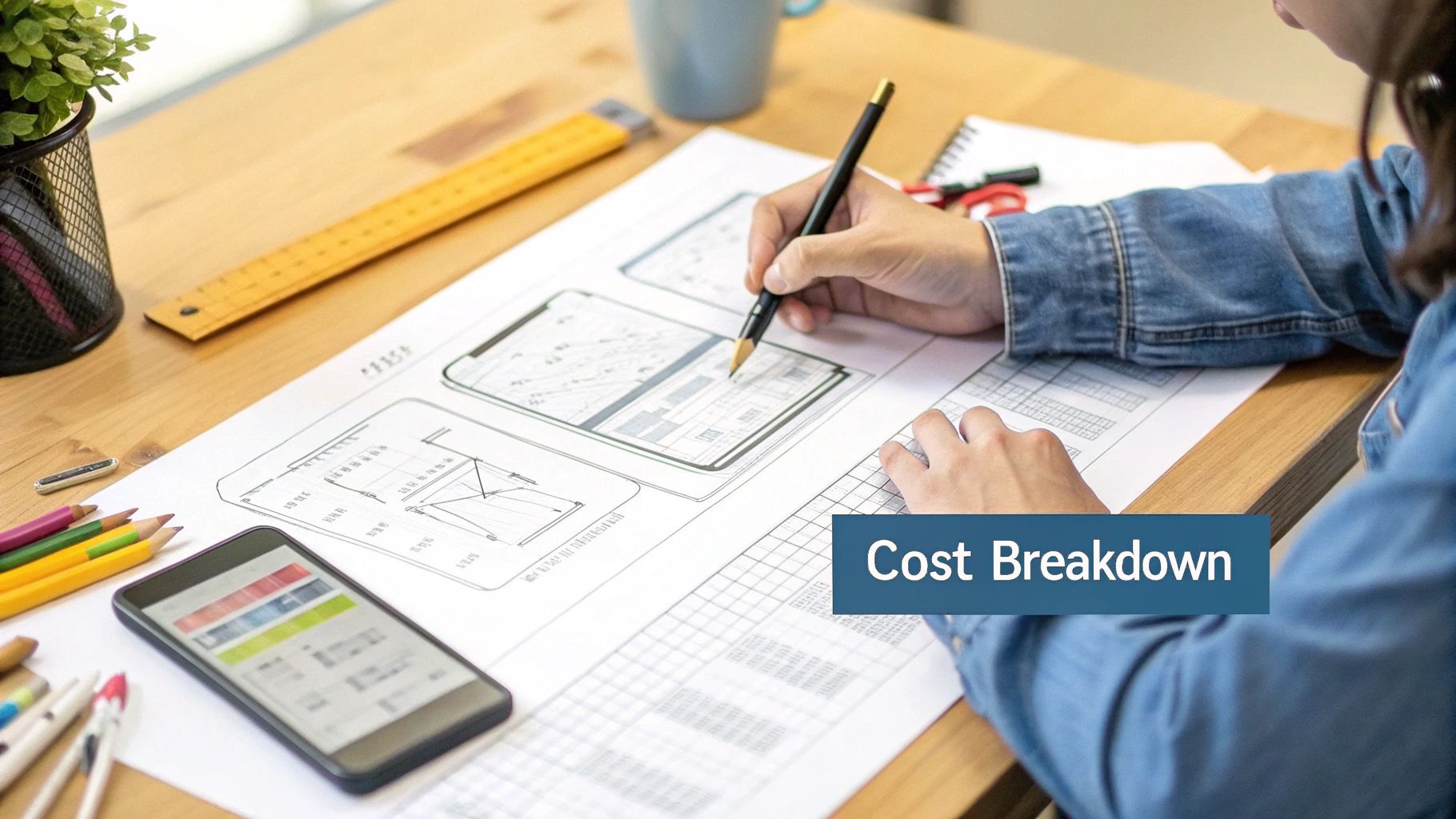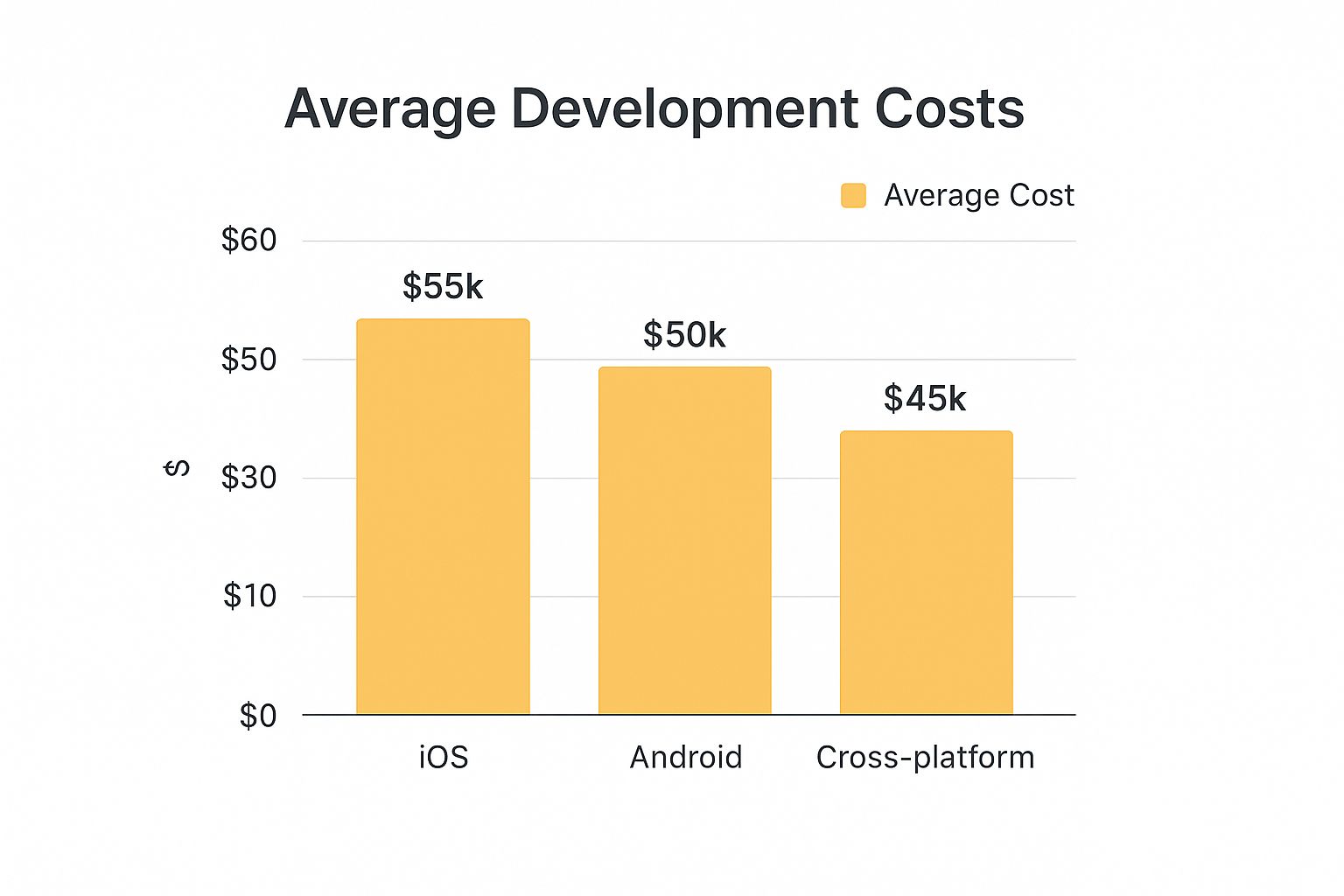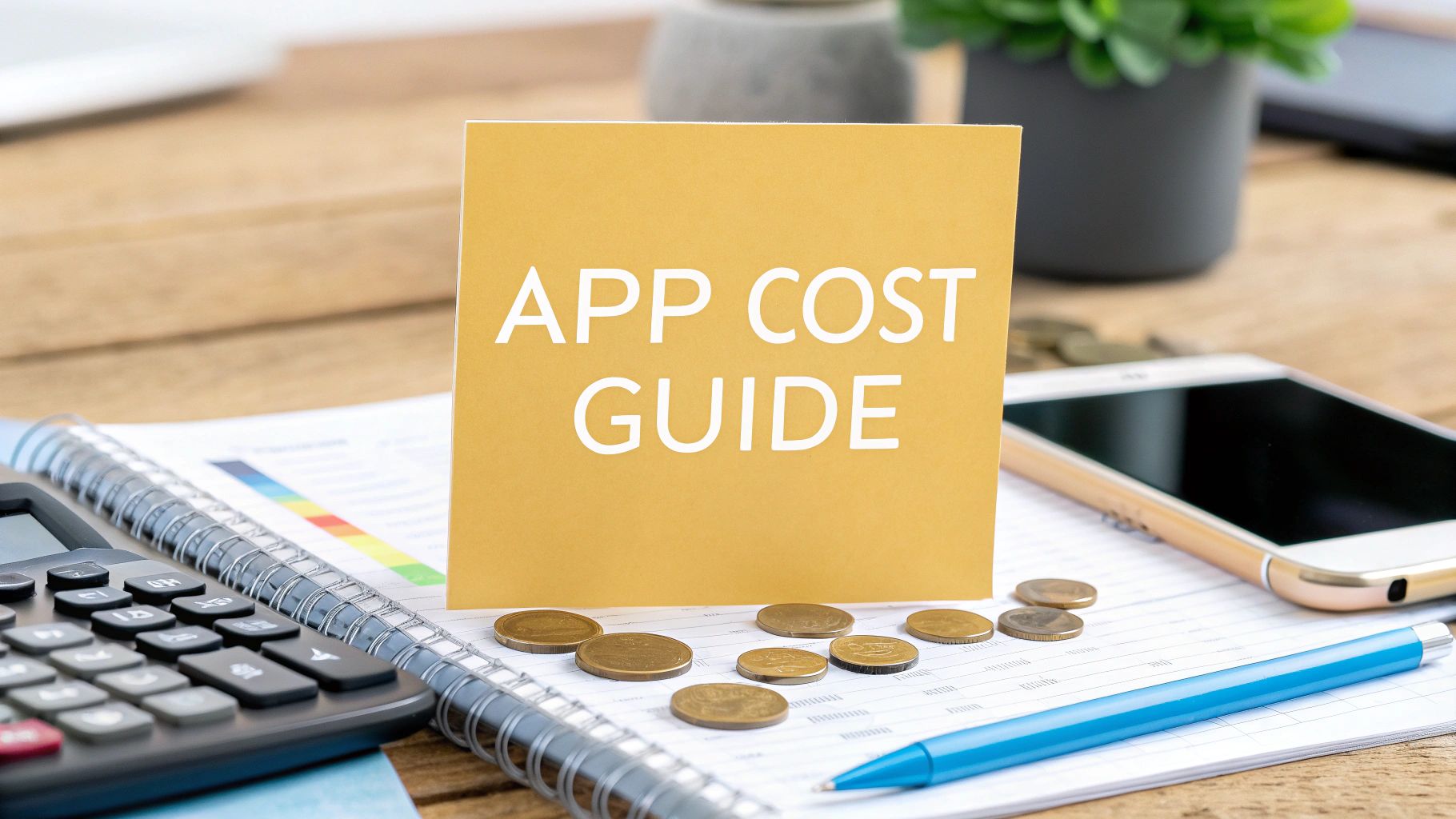So, you're wondering how much it costs to build an app. The short answer? It's a lot like asking how much it costs to build a house. A simple one-bedroom cabin in the woods is worlds apart from a custom mansion with a pool and a home theater. The final price tag lands anywhere from $40,000 for a simple app to over $400,000 for a complex, enterprise-level tool.
The final number really boils down to what you want your app to do—the features, the design, and the tech you build it on all play a huge role.
Decoding Your App Development Investment
Figuring out the budget is the first step toward making a smart move. That huge price range exists because no two apps are the same. A basic utility app—think a simple calculator or timer—is a much smaller project than a full-blown e-commerce platform with secure payments, user accounts, and a custom backend.
To give you a clearer picture, let's break things down by complexity. In 2025, a pretty basic app with a few core features will typically cost between $40,000 and $100,000 and take about 3 to 6 months to get off the ground. Apps with more moving parts, like social features or payment integrations, usually fall between $100,000 and $200,000, and you can expect a 6 to 9 month timeline. Some industry reports confirm these ranges, and the difference always comes back to the complexity of the design, the backend infrastructure, and the specific features you need.
Visualizing the Cost Breakdown
To get a quick, high-level feel for the financial landscape, this table lays out the typical costs and timelines you can expect for each tier of app development. It’s a good starting point before we dig deeper into what actually drives these numbers.
Estimated App Development Cost and Timeline by Complexity
| App Complexity | Estimated Cost Range | Estimated Timeline | Example Apps |
|---|---|---|---|
| Simple | $40,000 - $100,000 | 3 - 6 Months | Calculator, Basic Timer, Simple Informational App |
| Moderate | $100,000 - $200,000 | 6 - 9 Months | Local E-commerce Store, Restaurant Ordering App |
| Advanced | $200,000 - $400,000+ | 9 - 12+ Months | Social Media Platform, Complex FinTech App |
This table helps illustrate why a one-size-fits-all answer just doesn't work for app development. Each level represents a big jump in the time and resources needed, from coding hours to project management and testing.
At its core, the formula for calculating cost is pretty straightforward: (Development Hours) x (Developer’s Hourly Rate). So, if a project takes 2,500 hours and the developer's rate is $40/hour, you’re looking at a $100,000 investment.
Understanding these tiers is especially important for startups trying to make every dollar count. If you're exploring options for your first launch, our services for startup app development are designed to help you navigate these early, critical decisions. In the next sections, we’ll get into why these costs are a worthwhile investment and break down exactly where that money goes.
Why Apps Are a Billion Dollar Investment
 Before we start crunching numbers, let's get one thing straight about mobile app development cost. Why are companies lining up to drop hundreds of thousands of dollars on a single application? The answer is simple: it's where the people are.
Before we start crunching numbers, let's get one thing straight about mobile app development cost. Why are companies lining up to drop hundreds of thousands of dollars on a single application? The answer is simple: it's where the people are.
Think of an app not just as an expense, but as a direct line to your audience. It's like building a flagship store on the busiest street in the world—a street everyone happens to carry in their pocket. And that digital real estate is getting more valuable by the day.
The global mobile app market is proof of this, with projections showing it will swell to an incredible $935 billion by 2025. This explosive growth is driven by a user base that's closing in on five billion people worldwide. For any business, that's a mind-boggling opportunity for sales, engagement, and just making things run smoother. You can dig into more stats about this booming market on GoldenOwl.asia.
Meeting Customers Where They Live
These days, the customer journey pretty much begins and ends on a smartphone. The data doesn't lie: people spend a whopping 88% of their mobile time inside apps, not scrolling through web browsers. This creates a focused, less distracting space where your brand can actually build a relationship.
An app lets you connect with customers on their own terms. It offers a level of convenience and personalization that a mobile website just can't touch. From push notifications that reel users back in to exclusive in-app deals, your app can become a genuine part of their daily life.
The average person uses around 10 apps every single day and 30 different apps each month. If you can earn a spot in that rotation, your brand has achieved a level of loyalty that’s incredibly hard to replicate anywhere else.
The Strategic Choice Between iOS and Android
A huge chunk of your initial investment comes down to a big decision: which platform do you build for first? This choice directly shapes your mobile app development cost and who you can reach. The two giants, Android and iOS, serve very different slices of the global market.
- Android's Global Dominance: With a massive 71.88% of the global mobile OS market, Android gives you unmatched reach. It’s the king in fast-growing markets across Asia, South America, and Africa.
- iOS's Premium Market Share: In contrast, iOS holds about 27.65% globally. But it’s a powerhouse in high-income regions like North America and Western Europe, where users are known to spend more money within apps.
Deciding between them isn't just a tech question; it's a business strategy. Are you trying to capture the biggest audience possible, or are you targeting a market with higher spending habits? A lot of businesses eventually build for both, but kicking off with one is a smart way to manage costs and test the waters.
Ultimately, the high price of app development is a direct reflection of its massive potential. A well-designed, strategically launched app isn't just a piece of software. It’s a scalable business asset that can drive revenue, build lasting customer relationships, and give you a serious edge for years to come.
Where Your Money Goes in the Development Lifecycle

Breaking down the mobile app development cost is a lot easier when you see it as a journey, not just a single price tag. Think of it like building a custom house. You don't just pay for the finished building; you pay for the architect's blueprints, the foundation, the framing, the electrical work, and the interior finishes. Every single stage adds real value and has its own cost.
The app development lifecycle follows a similar path, broken into four key phases that take your idea from a concept to a real product on your users' phones. Each phase eats up a certain part of your budget, and trying to skip or rush one almost always creates bigger, more expensive headaches later on. Let’s pull back the curtain and see exactly how those costs add up.
Phase 1: Discovery and Planning
This is where the blueprint for your app gets made. Before anyone writes a single line of code, your development partner needs to dig in deep—to understand your vision, scope out the market, and nail down exactly what this project will and won't do. It’s the most important first step, making sure everyone is on the same page and preventing costly U-turns down the road.
The discovery phase usually covers things like:
- Market Research: Sizing up the competition and finding a unique angle for your app.
- Defining the MVP: Figuring out the absolute must-have features for a successful launch (your Minimum Viable Product).
- Technical Specification: A detailed document mapping out every function, feature, and technical need.
- Monetization Strategy: Deciding how your app will actually make money—ads, subscriptions, in-app purchases, etc.
This initial stage is a serious investment. In fact, the discovery phase can account for 10-15% of your total budget, typically landing between $5,000 and $40,000 and taking anywhere from one to four weeks. It might feel like a lot to spend on just planning, but this phase is your best insurance policy against building an app nobody wants.
Phase 2: UI and UX Design
With a solid plan in place, the focus shifts to how the app will look and feel. This is where User Interface (UI) and User Experience (UX) designers step in to shape the visual identity and create a natural, intuitive flow. Good design is way more than just picking nice colors; it's about crafting an effortless experience that makes people want to stick around.
This phase can take up a decent chunk of the budget—around 20-25%—because it has a massive impact on whether users stay or leave. A clunky, confusing design will send people running. The process starts with simple wireframes (think basic sketches of layouts) and moves to high-fidelity mockups and interactive prototypes that give you a real feel for the final product, letting you gather feedback before the heavy lifting of development begins.
Phase 3: Development and Testing
Here we go—this is the longest and most expensive part of the whole project. It's the "construction" phase where developers take all the plans and designs and actually bring them to life. This is where the biggest piece of your budget goes. Developers will write the front-end code (everything the user sees and interacts with) and the back-end code (the server, database, and logic that make it all work).
At the same time, Quality Assurance (QA) engineers are trying their best to break the app. They hunt for bugs, test performance, and make sure everything works perfectly across different devices and operating systems. Kicking off testing early and running it alongside development is the smart way to catch problems before they get tangled deep in the code and become a nightmare to fix. Our detailed guide on software development cost estimation can help you budget for this complex phase.
Key Takeaway: The development and testing phase is where the bulk of your investment goes. The complexity of your features, any third-party integrations, and the backend infrastructure are what really drive the cost here.
Phase 4: Deployment and Maintenance
Your app is finally ready for the spotlight. The deployment phase is all about getting it ready to launch on the Apple App Store and Google Play Store. This involves creating marketing assets, writing compelling app descriptions, and navigating the often-tricky submission and review process for each platform.
But the work isn't over once you hit "launch." You have to budget for ongoing maintenance, which typically runs 15-20% of the initial development cost every year. This covers things like server hosting, fixing bugs that pop up, updating for new operating systems, and rolling out new features based on user feedback to keep your app secure, relevant, and running smoothly.
The Biggest Factors That Drive Up App Costs
Ever wondered why one app gets a quote for a manageable $50,000 while a seemingly similar one comes back at $500,000? That huge gap in the mobile app development cost isn't just arbitrary. It’s the direct result of specific choices and features that act as cost multipliers, turning a simple idea into a complex and expensive project.
Think of it like commissioning a custom car. A basic sedan will get you from point A to B just fine. But once you start adding a high-performance engine, a bespoke leather interior, advanced navigation, and a custom paint job, the price skyrockets. App development works the same way—every feature, design choice, and technical decision directly impacts the final budget. Let's break down the biggest things that drive these costs.
App Complexity and Feature Set
The single biggest cost driver is the complexity of your app, which really just comes down to its feature set. More features mean more development hours, more testing, and a more intricate backend to support everything. A simple utility app with a single function is worlds away from a social media platform that has to handle real-time messaging, video streaming, and complex user profiles.
For instance, a basic user login using an email and password might take 30-40 hours to build. But if you want to integrate social media logins (like Google or Facebook), that adds another layer. Then, if you decide you need two-factor authentication for better security, the hours—and the costs—keep climbing.
This exponential increase applies to just about every aspect of an app.
- Simple Features: These are the foundational bits, like user registration, push notifications, and a basic admin panel. They're relatively straightforward to implement.
- Advanced Features: This is where you get into things like payment gateway integrations, real-time maps, and in-app chat. These take a lot more development time and often involve plugging into third-party services.
- Highly Complex Features: Cutting-edge stuff like AI-powered recommendations, augmented reality (AR) viewers, or intricate video calling can easily add tens of thousands of dollars to your budget. A video call feature alone can demand 300-400 hours of development.
A feature-rich application can easily sail past the $100,000 mark, while a focused Minimum Viable Product (MVP) with only the absolute core functionalities might be built for a fraction of that. Prioritizing features is the most effective way to control your initial investment.
Features are the building blocks of your app's cost, and it's easy to see how quickly the hours can add up. Here’s a quick look at how different features can impact your timeline and budget.
Cost Impact of Common App Features
| Feature | Complexity Level | Estimated Added Hours | Potential Cost Impact |
|---|---|---|---|
| User Login (Email/Social) | Low | 40 - 60 hours | +$2,000 to $6,000 |
| Push Notifications | Low | 30 - 50 hours | +$1,500 to $5,000 |
| In-App Purchases | Medium | 80 - 120 hours | +$4,000 to $12,000 |
| Geolocation & Maps | Medium | 100 - 150 hours | +$5,000 to $15,000 |
| Real-Time Chat | High | 150 - 250 hours | +$7,500 to $25,000 |
| Video/Audio Streaming | High | 300 - 400 hours | +$15,000 to $40,000+ |
| AI/ML Integration | Very High | 400+ hours | +$20,000 to $50,000+ |
As you can see, what seems like a simple "add-on" can introduce hundreds of hours of complex work. Being selective about what goes into your version 1.0 is key to managing your budget.
Platform Choice and Technology Stack
Your choice of platform—iOS, Android, or both—is another critical decision that heavily influences the mobile app development cost. Each option comes with its own financial and strategic trade-offs. Building natively for a single platform, like iOS, means creating an app specifically for Apple devices using their preferred language, Swift. This approach delivers the absolute best performance and user experience.
But what if you want to reach everyone on both iOS and Android? Building two separate native apps essentially doubles your development cost. You’ll need two distinct codebases and often two separate development teams with specialized skills for each platform. It's a huge commitment.
To manage these costs, many businesses opt for cross-platform development using frameworks like React Native or Flutter. This approach lets developers write one codebase that works on both iOS and Android, which can trim initial development costs by 20-40%. While this is a budget-friendly route, it can sometimes come with performance limitations compared to a fully native app.
This infographic breaks down the average cost differences between these approaches.

As the data shows, cross-platform development offers a clear cost advantage, making it an attractive option for startups and businesses trying to make their budget stretch further.
Custom Design and User Experience
Finally, the level of customization in your app's design plays a major role in the final cost. A visually stunning and highly intuitive app can be a powerful differentiator, but it definitely comes at a price. The design process is broken into two key parts: User Experience (UX) and User Interface (UI).
- UX Design: This is all about the app's flow and logic, making sure it's easy and even enjoyable to use. A UX designer maps out user journeys, creates wireframes, and builds prototypes. This foundational work can start at around $5,000.
- UI Design: This involves creating the app's visual elements—the colors, fonts, icons, and animations. A basic UI that uses standard templates is the most affordable option.
A custom UI, however, is where costs can really escalate. Creating unique visual elements, intricate animations, and custom gestures requires a ton of time from skilled designers. A simple design might cost $10,000, but a highly polished, custom design with complex animations can easily exceed $25,000. While a template-based design is cheaper upfront, investing in a unique and memorable user experience often pays for itself through higher user engagement and retention down the line.
What About Hidden Costs and Life After Launch?
Thinking your spending stops the day your app goes live is a pretty common mistake, and honestly, a costly one. Launching an app isn't crossing the finish line—it's more like the starting gun for a marathon. Your app isn't a one-and-done purchase; it’s a living, breathing product that needs constant care and feeding to stay functional, secure, and relevant.
Too many entrepreneurs get blindsided by these post-launch expenses. They can absolutely wreck a budget that was only built for the initial development phase. It's like buying a high-performance sports car but completely forgetting to budget for gas, insurance, or oil changes. Sooner or later, you're going to break down on the side of the road.
Uncovering the Day-to-Day Operational Costs
That initial development fee? It's just the tip of the iceberg. Under the surface, there’s a whole world of essential, recurring expenses that are non-negotiable for keeping your app running smoothly. These aren't optional upgrades; they're the fundamental costs of doing business in a crowded digital market.
Here are some of the big ones you need to plan for right out of the gate:
- Server and Backend Hosting: All your app's data has to live somewhere. Whether you go with a cloud service like AWS or Google Cloud, you’ll have monthly hosting fees that grow as your user base and data needs expand.
- Third-Party API Subscriptions: Does your app use maps, process payments, or send out text messages? Services like the Google Maps API, Stripe, or Twilio all run on subscription models. As your app gets more popular, these bills will climb.
- Routine App Maintenance: Bugs don’t magically vanish after launch day. You'll need developers on hand to continuously monitor for glitches, crashes, and performance bottlenecks. This means dedicated time for bug squashing and code tune-ups.
- Crucial OS Updates: Apple and Google roll out major updates to their operating systems every single year. Your app has to be updated to stay compatible with the latest versions of iOS and Android, otherwise, it could break or even get kicked out of the app stores.
A good rule of thumb is to budget 15-20% of your initial development cost for annual maintenance. So, if your app cost $100,000 to build, you should set aside another $15,000 to $20,000 each year just to keep it healthy.
Planning for the Long Haul
Beyond just keeping the lights on, your post-launch budget needs to account for growth and evolution. The app you launch is just version 1.0. To stay competitive and keep your users from wandering off, you’ll need to invest in future updates and new features based on what your users are telling you and where the market is headed.
Think about these forward-looking expenses:
- Feature Updates and Enhancements: Adding new functionality is how you keep users engaged and attract new ones. This involves the same cycle of design, development, and testing as the initial build.
- Marketing and User Acquisition: Your app won't get discovered on its own. You need a dedicated marketing budget for things like social media ads, content marketing, or influencer partnerships to actually drive downloads.
- Customer Support: As more people start using your app, you'll need a system in place to handle their questions, complaints, and feedback.
- Security and Compliance: Protecting user data is absolutely non-negotiable. Regular security audits, penetration testing, and updates to comply with regulations like GDPR are essential investments, not luxuries.
By budgeting for these hidden costs from the start, you move from a short-sighted launch plan to a sustainable, long-term strategy. This kind of foresight protects your initial investment and gives your app the best possible shot at thriving for years to come.
How to Lower Your App Development Cost

Knowing what drives up your mobile app development cost is one thing. Actually finding smart ways to manage that budget without ending up with a flimsy product is the real challenge. The good news is, there are several proven ways to build an effective app while keeping your expenses grounded.
Think of it less like cutting corners and more like building smarter. You wouldn't try to build a mansion on a starter-home budget. Instead, you'd focus on building a strong, functional house first and then add the extra wings and fancy landscaping later. That's the approach we're talking about—it protects your investment and sets you up for long-term success.
Start with a Minimum Viable Product
One of the single most effective ways to manage costs is to launch with a Minimum Viable Product (MVP). An MVP isn't just a cheap, stripped-down version of your app. It’s a highly focused version that includes only the absolute essential features needed to solve one core problem for your users. Done right, this approach can slash your initial development costs by as much as 55%.
Launching with an MVP gets you a few critical wins right out of the gate:
- Validate Your Idea: You get to test your core concept with real people before sinking a massive budget into features they might not even want.
- Gather Real Feedback: The data you get from early users is gold. It tells you exactly where to invest your money next.
- Faster Time-to-Market: A smaller feature set means a much quicker development cycle, getting your app into users' hands and potentially generating revenue sooner.
This lean strategy keeps you from over-investing in unproven ideas. If you're looking to launch efficiently, exploring https://upnorthmedia.co/services/mvp-app-development can give you a clear roadmap for a successful, budget-conscious release.
Embrace Cross-Platform and Open-Source Solutions
The technology you choose has a massive impact on your final bill. Native apps deliver peak performance, but building separate apps for both iOS and Android can easily double your development costs. This is where cross-platform development becomes a total game-changer.
By using frameworks like React Native or Flutter, developers can write a single codebase that works on both platforms. This approach can reduce initial development costs by 20-40% and significantly speed up the entire process.
On top of that, leveraging open-source libraries and APIs for common functions is a huge time-saver. Why build standard features like user authentication or push notifications from scratch? Your team can plug in pre-built, community-tested components, which not only cuts down on development hours but often results in more stable and secure code.
Prioritize Features and Outsource Strategically
Scope creep—that slow, uncontrolled trickle of "just one more feature"—is a notorious budget-killer. To fight it, you have to be ruthless about prioritizing your feature list. Sort everything into three buckets: "must-haves," "nice-to-haves," and "can-wait-for-version-2.0." This discipline keeps your team focused and your budget locked in.
Another powerful move is to consider outsourcing development to regions with more competitive rates. The cost difference can be huge; developers in Eastern Europe often charge 30-60% less than their North American counterparts for similar quality work. This can make a high-end app suddenly feel much more attainable.
For simpler projects, it's also worth understanding what no code development entails, as it can allow for rapid creation without needing a full-scale coding team. When you combine these strategies, you create a powerful playbook for lowering your mobile app development cost while still delivering a product that wows.
Wrapping Up: Common Questions About App Development Costs
When you’re trying to nail down a budget, a few nagging questions can create a lot of uncertainty. Let's wrap things up by tackling some of the most common questions we hear about app development costs.
Think of this as a final sanity check to clear up any confusion before you take the next step. We'll get into the classic platform debate, the cheapest way to get your idea off the ground, and how to get a price tag you can actually trust.
Is It More Expensive to Build for iOS or Android?
Ah, the classic question. The answer isn't as simple as one being flat-out cheaper than the other. While iOS developers can sometimes have slightly higher hourly rates, Android development often ends up costing more when all is said and done. Why? The biggest reason is device fragmentation.
The Android world is a wild west of thousands of different devices from countless manufacturers. Each one has its own screen size, hardware quirks, and OS version. This chaos means developers have to spend a ton more time testing and tweaking to make sure the app doesn't break for a huge chunk of users. Apple's world, on the other hand, is a walled garden with only a handful of devices to worry about, which makes the quality assurance process much more straightforward and less time-consuming.
Key Takeaway: Don't just look at hourly rates. The massive amount of testing required for Android’s fragmented market often makes its total development cost the same as, or even higher than, an iOS-only app.
What Is the Cheapest Way to Create an App?
If your main goal is to get to market without breaking the bank, you have two solid options. The first is to build a Minimum Viable Product (MVP). This means you focus only on the absolute, must-have features to solve a core problem for your users. You launch a lean, functional app for a fraction of what a full-featured product would cost, letting you test the waters with real people before you pour more money into it.
Your second option is to check out no-code or low-code platforms. These tools let you build simple apps using drag-and-drop interfaces and pre-built templates, which cuts down the need for expensive custom coding. They definitely have their limits when it comes to complexity and customization, but for basic app ideas, they're a fantastic, low-cost way to get started.
How Can I Get an Accurate Cost Estimate?
There's only one way to get a real, reliable estimate: create a detailed project scope document and talk to a development agency. Just saying you want "an app like Uber" is way too vague—it’s like asking a builder for a quote on "a house with rooms."
To get a quote you can actually count on, you need to clearly define a few things:
- Core Features: Make a list of every single thing you want the app to do.
- Target Platform(s): Are you aiming for iOS, Android, or both? Be specific.
- Design Requirements: Do you need a completely custom UI, or are you okay starting with templates?
A professional development partner will take this info and build out a detailed proposal, breaking down the estimated hours for every single task. That kind of transparency is the only way to truly understand what it will cost to bring your vision to life.
Ready to turn your app idea into reality with a clear, predictable budget? Up North Media specializes in creating custom web applications that drive growth. We provide transparent cost estimates and strategic guidance to ensure your project aligns with your business goals. Contact us today for a free consultation and let's build something great together.
